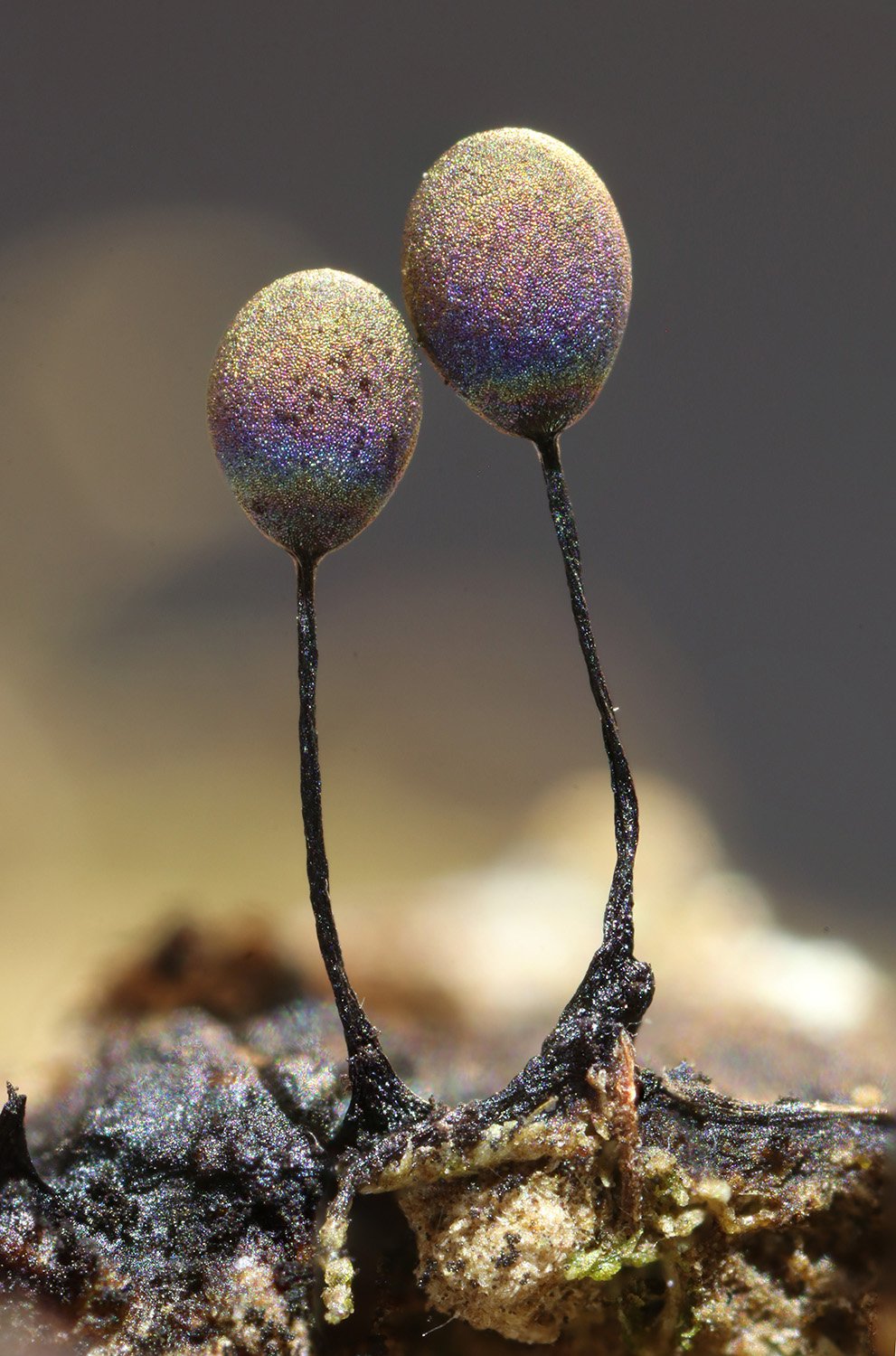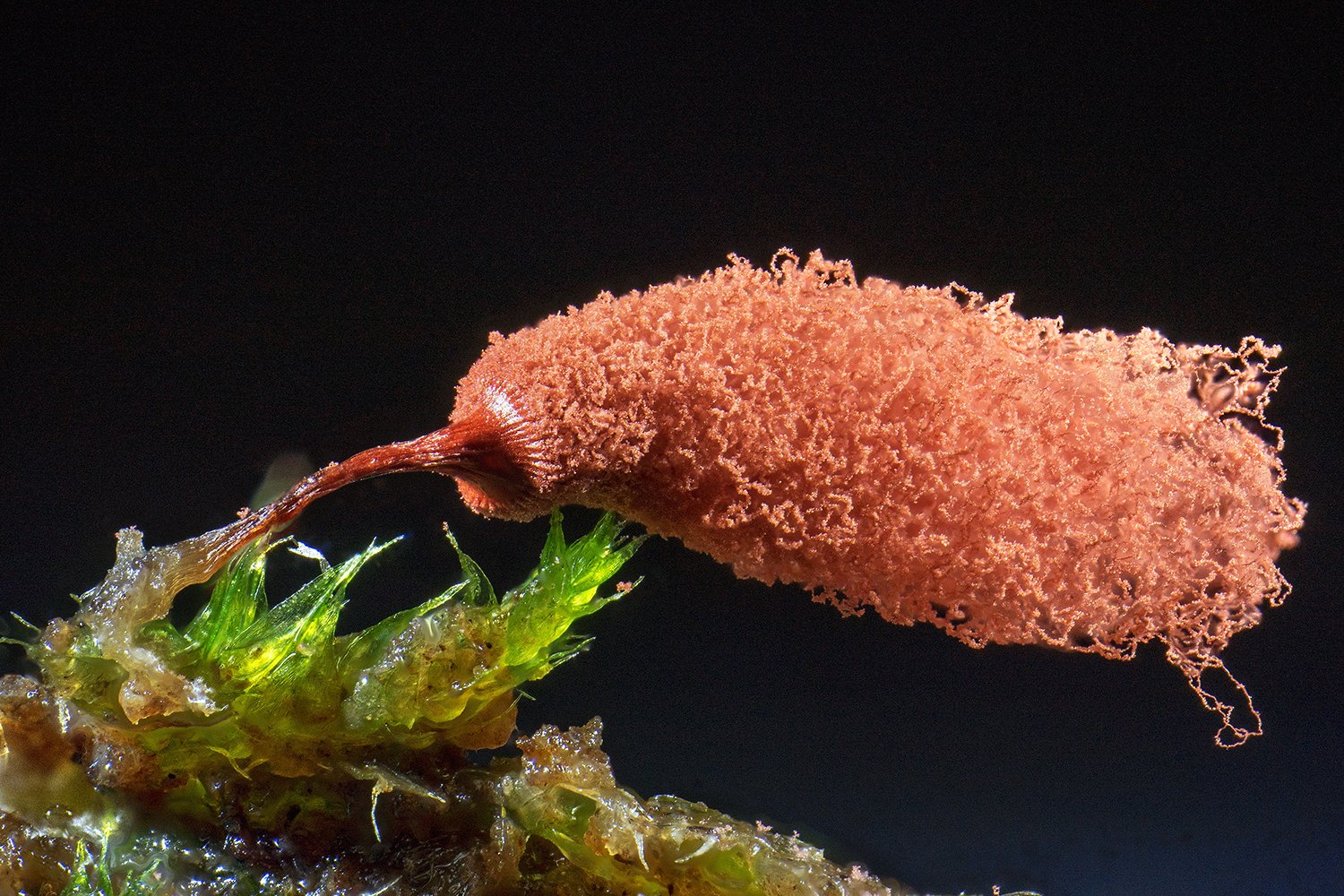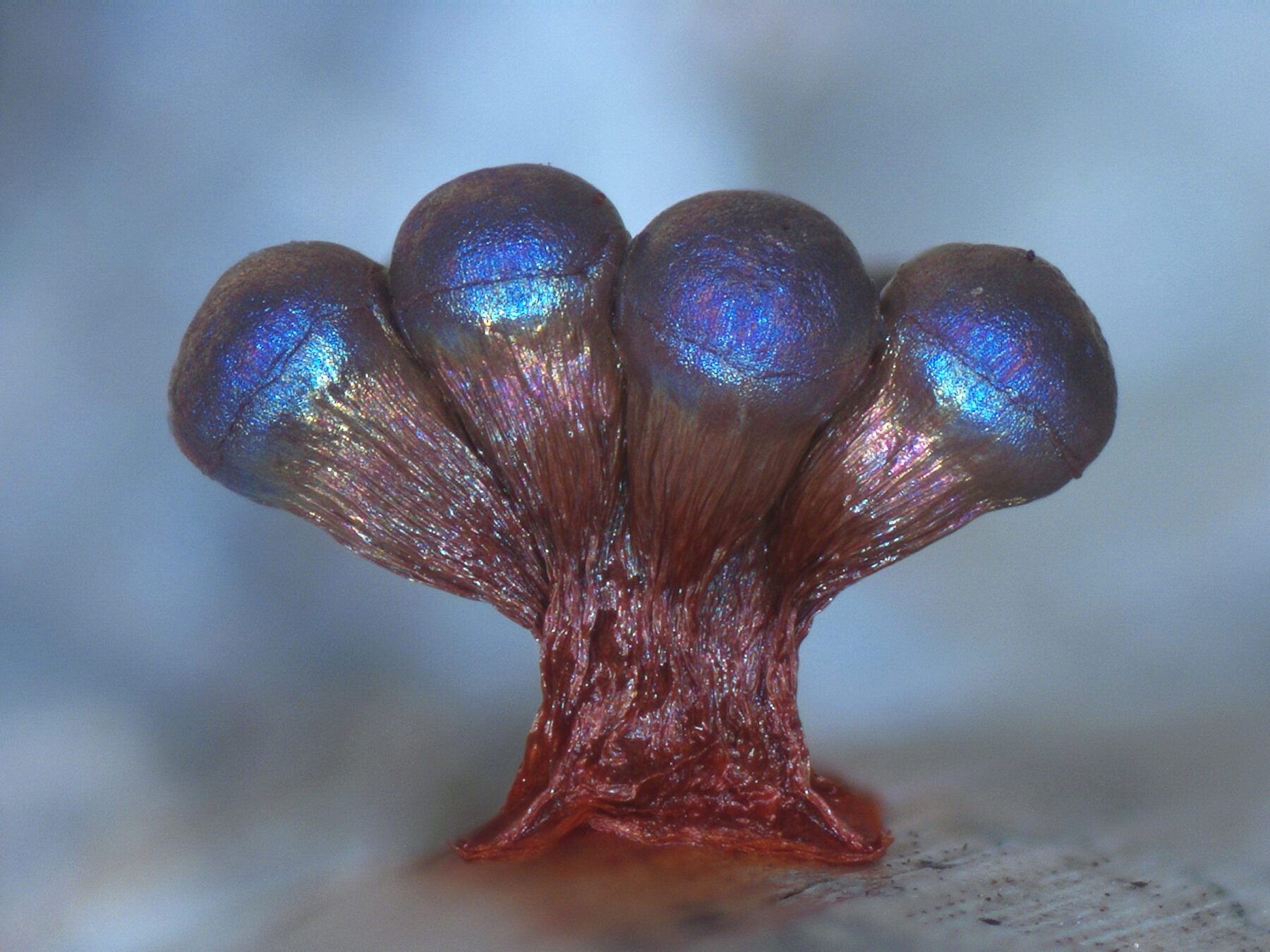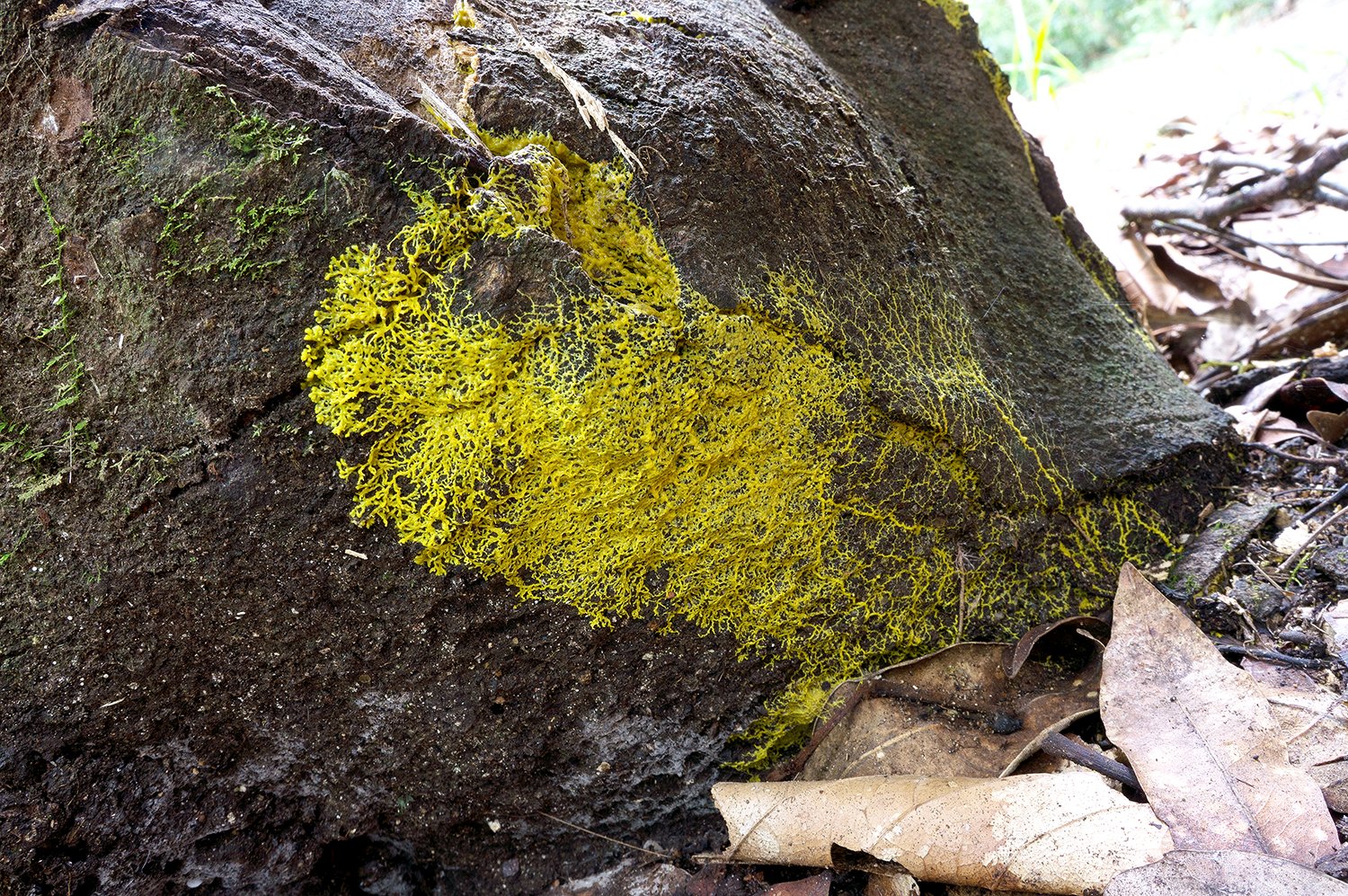Sarah Lloyd has risen early every morning for the past 10 years hoping to catch sight of bizarre and tiny life forms in old logs and leaf litter in the gullies of the tall wet eucalypt forest on Black Sugarloaf Mountain in northern Tasmania, where she’s lived since 1988. These damp places provide the perfect habitat for slime moulds – organisms that exist only briefly in their most visible form. “They don’t last long in the field, so you have to be quick,” Sarah explains.
Slime moulds are primitive, single-celled organisms that live mostly in moist terrestrial habitats where they feed on bacteria, fungi and decaying organic matter. For much of their lives they exist in microscopic form. But during what’s known as the plasmodial stage of their life cycle, they coalesce en masse into large blobs that consist of millions of nuclei, forming single, much larger, cells that can sometimes span up to a metre.
On the forest floor, a slime mould in this plasmodium stage can resemble a strange substance that’s perhaps been accidentally leaked from a nuclear power plant. One particular species, Fuligo septica, with the common names of dog vomit or scrambled eggs, is bright yellow and hard to miss.

Also at this stage slime moulds often produce strange-looking fruiting bodies that can, for example, take the form of glittery, purple orbs or lumps of freshly chewed pink bubble gum. “They’re seriously made for sci-fi,” Sarah says, adding that quite a few famous science fiction films – including Phase IV, Invasion of the Body Snatchers and The Blob – are thought by some to be based on the biology, appearance and behaviour of slime moulds.
There’s long been much confusion about how these extraordinary life forms should be classified and where they fit with other organisms. They look more like fungi than anything else, and before microscopes, both fungi and slime moulds were classified as plants.
Then in 1969 fungi were, like plants or animals, allocated their own kingdom and slime moulds were lumped in with them. Sometime later, slime moulds were temporarily moved to the animal kingdom and then to the kingdom Protista, which contains lots of organisms that don’t fit anywhere else. Today they are consigned to the kingdom Protozoa.
During the past two decades Sarah has become one of the leading experts on Australia’s slime moulds and has documented at least 2000 individual examples in Tasmania alone. These represent 120 different species – more than 10 per cent of the total 1000 species known so far worldwide – including three species scientifically described by Sarah. Before she began her research, just 42 slime mould species were known from Tasmania. Australia-wide there are now 260 species described so far, but that number grows annually.

The weird and whacky behaviour of slime mould
The behaviour of slime moulds can be as odd as their appearance. Time-lapse photography has shown the plasmodium stage pulsating in the direction of food such as fungi and bacteria, sometimes travelling up to several metres in a single day. This, and evidence of navigational skills in an organism with no brain, has attracted countless research papers.
In 2012 an international research group, which included Australian scientists, placed a slime mould into a petri dish with a U-shaped trap containing food and witnessed something truly extraordinary. They observed the slime mould avoiding places it had already explored by detecting and avoiding the extracellular slime it had left behind. It was the first time that spatial memory had been demonstrated by a unicellular organism.
Slime moulds also appear to get ‘smarter’ as they get bigger. In 2016 French scientists discovered that slime moulds, when fusing together during the plasmodial stage, are able to pass on learnt behaviour, which allows them to speed up the journey to find food. This suggests they can remember, learn and transfer knowledge.
Because slime moulds seem to be so efficient at finding optimal pathways, scientists have been increasingly turning to them for answers to some complex societal problems.
In 2010 scientists from Japan and the UK, who were trying to optimise Japan’s complicated rail system, placed oat flakes onto a map of cities surrounding Toyko. They watched as a slime mould created its own networks between each of the locations to get at the oats, which are a favoured food. Rather than moving as a whole, the slime mould created tunnel-like veins to the flakes, choosing the most efficient routes for feeding. The scientists were shocked when the resulting pattern was almost identical to Japan’s rail system.
Most recently, NASA announced it had created an algorithm based on slime mould growth patterns that use optimal pathways to connect to food sources, to help map the cosmic web, the dark matter distributed across the universe after the Big Bang.
“It’s really fascinating that one of the simplest forms of life actually enables insight into the largest-scale structures in the universe,” lead researcher Joseph Burchett commented.



Scientists have had great difficulty studying the evolutionary history of slime moulds because fossils of these tiny soft-bodied life forms are exceedingly rare. The oldest known slime mould fossil, dating back to the mid-Cretaceous period about 100 million years ago, was found encased in a fragment of amber from Myanmar. It revealed that very little has changed for slime moulds during those millions of years.
There’s a good chance, however, that slime moulds evolved even earlier. Compression fossils found in Gabon in Central Africa and dating back 1.8 billion years, well before the existence of multicellular animals, show something was moving around and leaving string-shaped tracks in the sediment. Scientists suspect the tracks could have been made by ancient slime moulds during the plasmodium stage.
At the time when those tracks would have been laid down, that area was a seabed, leading to the belief that slime moulds were once aquatic, colonising land at the same time plants did, 500 million years ago.

There’s a lot we don’t know about slime mould
Slime moulds are poorly studied everywhere but particularly here in Australia, despite the fact that we have such a large proportion of species.
“Most people studying slime moulds in Australia are actually mycologists [fungi experts], who include slime moulds here and there,” Sarah says.
“Other than myself and a few others, there’s no-one dedicated to them.”



American slime mould expert Dr Steve Stephenson, from the University of Arkansas, believes there’s much ground still to be covered in Australia.
CSIRO will publish his specialist book Secretive Slime Moulds: Myxomycetes of Australia in March. In the 1990s, Steve spent a lot of time looking for slime moulds in Australia’s tropical and subantarctic islands, including Christmas, Norfolk and Macquarie islands. He has also headed studies in southern Africa, which led to the discovery of 50 different slime mould species in the Namib Desert. Now he’s eager to begin searching Australia’s deserts.
“Most species of slime mould are cosmopolitan and can be found all over the world,” he says. “But at least a dozen new species have been described based on material from Australia, and some of these aren’t known from anywhere else in the world.”
Sarah says slime mould activity in her locality was down last year and the reasons remain unclear. “I’d say it depends on rain, but we really don’t know. They’re very unpredictable.”
Given slime moulds prefer wet temperate forests and Australia is predicted to become far drier during coming years, Sarah has no doubt climate change will impact them. The International Union for the Conservation of Nature is looking into this and there are widespread calls for more research.
There is much yet to learn about these widely underappreciated and largely misunderstood group of organisms. Who knows what lessons they may be able to teach us about the rapid changes now underway worldwide?

